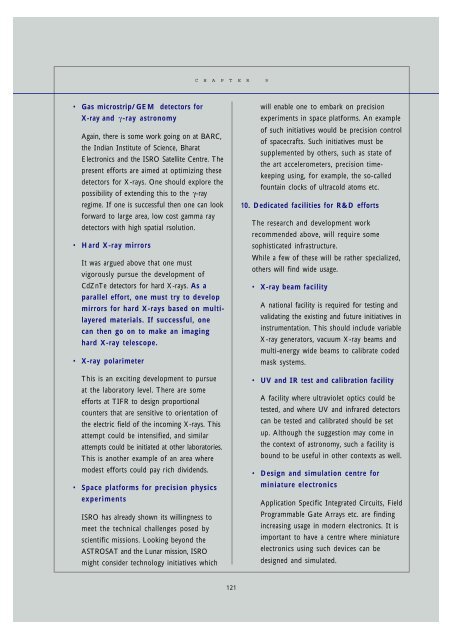2004 ASTRONOMY & ASTROPHYSICS - Indian Academy of Sciences
2004 ASTRONOMY & ASTROPHYSICS - Indian Academy of Sciences
2004 ASTRONOMY & ASTROPHYSICS - Indian Academy of Sciences
You also want an ePaper? Increase the reach of your titles
YUMPU automatically turns print PDFs into web optimized ePapers that Google loves.
CHAPTER 9<br />
• Gas microstrip/GEM detectors for<br />
X-ray and g -ray astronomy<br />
Again, there is some work going on at BARC,<br />
the <strong>Indian</strong> Institute <strong>of</strong> Science, Bharat<br />
Electronics and the ISRO Satellite Centre. The<br />
present efforts are aimed at optimizing these<br />
detectors for X-rays. One should explore the<br />
possibility <strong>of</strong> extending this to the γ-ray<br />
regime. If one is successful then one can look<br />
forward to large area, low cost gamma ray<br />
detectors with high spatial rsolution.<br />
• Hard X-ray mirrors<br />
It was argued above that one must<br />
vigorously pursue the development <strong>of</strong><br />
CdZnTe detectors for hard X-rays. As a<br />
parallel effort, one must try to develop<br />
mirrors for hard X-rays based on multilayered<br />
materials. If successful, one<br />
can then go on to make an imaging<br />
hard X-ray telescope.<br />
• X-ray polarimeter<br />
This is an exciting development to pursue<br />
at the laboratory level. There are some<br />
efforts at TIFR to design proportional<br />
counters that are sensitive to orientation <strong>of</strong><br />
the electric field <strong>of</strong> the incoming X-rays. This<br />
attempt could be intensified, and similar<br />
attempts could be initiated at other laboratories.<br />
This is another example <strong>of</strong> an area where<br />
modest efforts could pay rich dividends.<br />
• Space platforms for precision physics<br />
experiments<br />
ISRO has already shown its willingness to<br />
meet the technical challenges posed by<br />
scientific missions. Looking beyond the<br />
ASTROSAT and the Lunar mission, ISRO<br />
might consider technology initiatives which<br />
will enable one to embark on precision<br />
experiments in space platforms. An example<br />
<strong>of</strong> such initiatives would be precision control<br />
<strong>of</strong> spacecrafts. Such initiatives must be<br />
supplemented by others, such as state <strong>of</strong><br />
the art accelerometers, precision timekeeping<br />
using, for example, the so-called<br />
fountain clocks <strong>of</strong> ultracold atoms etc.<br />
10. Dedicated facilities for R&D efforts<br />
The research and development work<br />
recommended above, will require some<br />
sophisticated infrastructure.<br />
While a few <strong>of</strong> these will be rather specialized,<br />
others will find wide usage.<br />
• X-ray beam facility<br />
A national facility is required for testing and<br />
validating the existing and future initiatives in<br />
instrumentation. This should include variable<br />
X-ray generators, vacuum X-ray beams and<br />
multi-energy wide beams to calibrate coded<br />
mask systems.<br />
• UV and IR test and calibration facility<br />
A facility where ultraviolet optics could be<br />
tested, and where UV and infrared detectors<br />
can be tested and calibrated should be set<br />
up. Although the suggestion may come in<br />
the context <strong>of</strong> astronomy, such a facility is<br />
bound to be useful in other contexts as well.<br />
• Design and simulation centre for<br />
miniature electronics<br />
Application Specific Integrated Circuits, Field<br />
Programmable Gate Arrays etc. are finding<br />
increasing usage in modern electronics. It is<br />
important to have a centre where miniature<br />
electronics using such devices can be<br />
designed and simulated.<br />
121
















